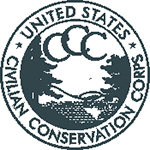History of Clear Creek State Park
The waterways of the Clear Creek Valley provided numerous springs for early European settlers’ subsistence, travel paths, and power. While roads like Truby Trail were eventually established, the Clarion River transported goods to large markets along the Allegheny River.
Most goods were timber related:
Logs
Bark for tanneries
Cut boards
In order for sawmills to cut trees into boards, lumbermen needed to harness the natural power of moving water. Bracket dams and mill ponds channeled this energy to move logs downstream and turn turbines, which ran the saws inside the mills.
Eventually steam power replaced the older turbines, but the industry remained attached to the waterways.
Successful lumbermen, George and William Frazier, owned a large tract of land in the valley during the late 1800s. George and his family resided in the valley while William oversaw the lumber yard in Pittsburgh.
Signs of the lumbering era remain for the scrutinizing eye and several features within the park bear the Frazier name.
After lumbering ceased in the valley and farming among the rock and eroded ground was abandoned, the property was sold to the state as forest land in 1919. The first public campsites at Clear Creek opened during 1922.
Civilian Conservation Corps Clear Creek Camp

A little more than 10 years later, after President Franklin D. Roosevelt’s initial inauguration and the start of the Civilian Conservation Corps (CCC), Clear Creek Camp S-53 was established.
A forest suppressed by gooseberry and chestnut blight received help at the hands of hundreds of men enlisted in the CCC. They planted numerous trees throughout the valley. From the formation of the camp to when they departed in 1937, they built the:
Cabins
Swimming area
Food concession building
Restrooms
Trails
Bridges
Roads
During 1987, the Clear Creek cabin colony, shelters, and several other facilities were added to the National Register of Historic Places.